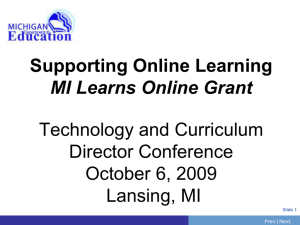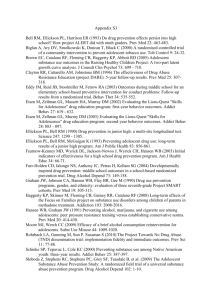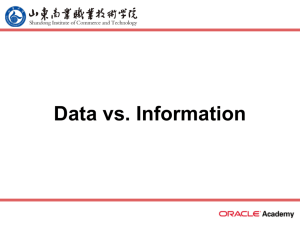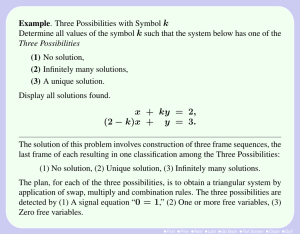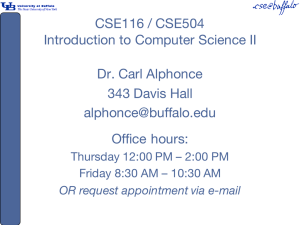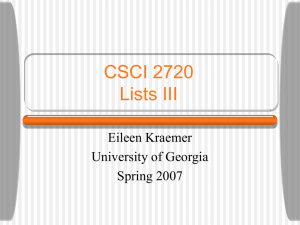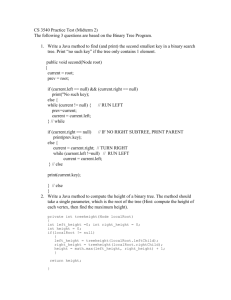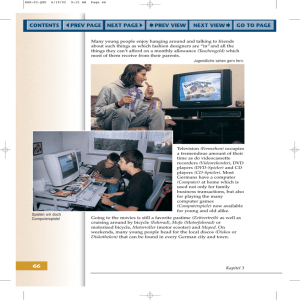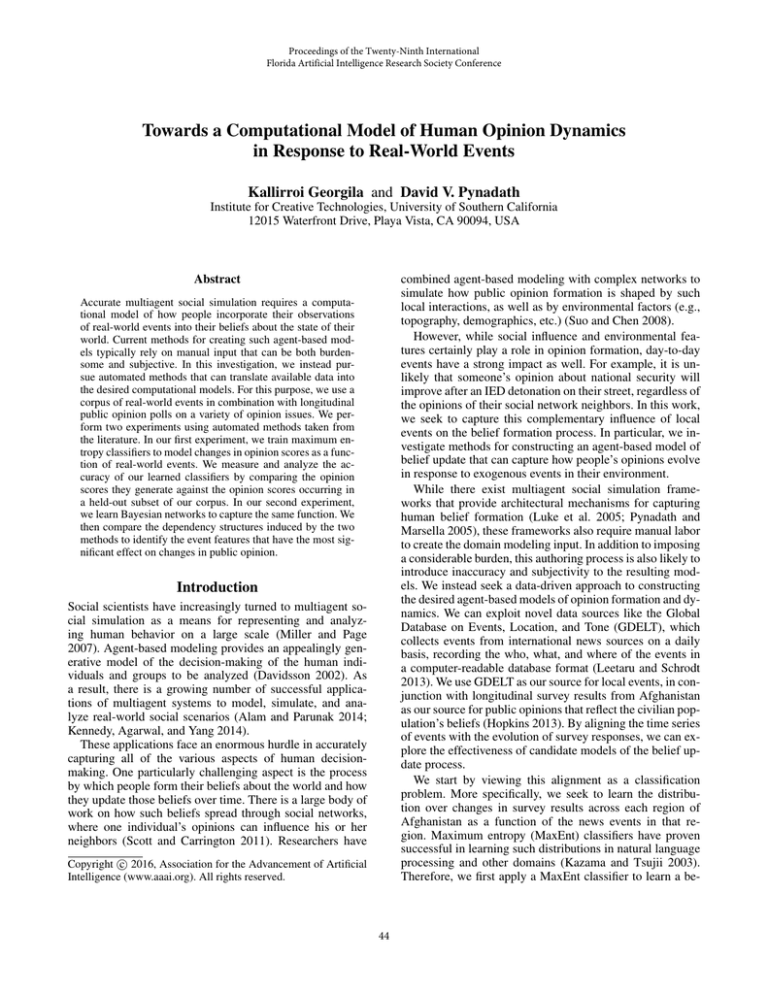
Proceedings of the Twenty-Ninth International
Florida Artificial Intelligence Research Society Conference
Towards a Computational Model of Human Opinion Dynamics
in Response to Real-World Events
Kallirroi Georgila and David V. Pynadath
Institute for Creative Technologies, University of Southern California
12015 Waterfront Drive, Playa Vista, CA 90094, USA
combined agent-based modeling with complex networks to
simulate how public opinion formation is shaped by such
local interactions, as well as by environmental factors (e.g.,
topography, demographics, etc.) (Suo and Chen 2008).
However, while social influence and environmental features certainly play a role in opinion formation, day-to-day
events have a strong impact as well. For example, it is unlikely that someone’s opinion about national security will
improve after an IED detonation on their street, regardless of
the opinions of their social network neighbors. In this work,
we seek to capture this complementary influence of local
events on the belief formation process. In particular, we investigate methods for constructing an agent-based model of
belief update that can capture how people’s opinions evolve
in response to exogenous events in their environment.
While there exist multiagent social simulation frameworks that provide architectural mechanisms for capturing
human belief formation (Luke et al. 2005; Pynadath and
Marsella 2005), these frameworks also require manual labor
to create the domain modeling input. In addition to imposing
a considerable burden, this authoring process is also likely to
introduce inaccuracy and subjectivity to the resulting models. We instead seek a data-driven approach to constructing
the desired agent-based models of opinion formation and dynamics. We can exploit novel data sources like the Global
Database on Events, Location, and Tone (GDELT), which
collects events from international news sources on a daily
basis, recording the who, what, and where of the events in
a computer-readable database format (Leetaru and Schrodt
2013). We use GDELT as our source for local events, in conjunction with longitudinal survey results from Afghanistan
as our source for public opinions that reflect the civilian population’s beliefs (Hopkins 2013). By aligning the time series
of events with the evolution of survey responses, we can explore the effectiveness of candidate models of the belief update process.
We start by viewing this alignment as a classification
problem. More specifically, we seek to learn the distribution over changes in survey results across each region of
Afghanistan as a function of the news events in that region. Maximum entropy (MaxEnt) classifiers have proven
successful in learning such distributions in natural language
processing and other domains (Kazama and Tsujii 2003).
Therefore, we first apply a MaxEnt classifier to learn a be-
Abstract
Accurate multiagent social simulation requires a computational model of how people incorporate their observations
of real-world events into their beliefs about the state of their
world. Current methods for creating such agent-based models typically rely on manual input that can be both burdensome and subjective. In this investigation, we instead pursue automated methods that can translate available data into
the desired computational models. For this purpose, we use a
corpus of real-world events in combination with longitudinal
public opinion polls on a variety of opinion issues. We perform two experiments using automated methods taken from
the literature. In our first experiment, we train maximum entropy classifiers to model changes in opinion scores as a function of real-world events. We measure and analyze the accuracy of our learned classifiers by comparing the opinion
scores they generate against the opinion scores occurring in
a held-out subset of our corpus. In our second experiment,
we learn Bayesian networks to capture the same function. We
then compare the dependency structures induced by the two
methods to identify the event features that have the most significant effect on changes in public opinion.
Introduction
Social scientists have increasingly turned to multiagent social simulation as a means for representing and analyzing human behavior on a large scale (Miller and Page
2007). Agent-based modeling provides an appealingly generative model of the decision-making of the human individuals and groups to be analyzed (Davidsson 2002). As
a result, there is a growing number of successful applications of multiagent systems to model, simulate, and analyze real-world social scenarios (Alam and Parunak 2014;
Kennedy, Agarwal, and Yang 2014).
These applications face an enormous hurdle in accurately
capturing all of the various aspects of human decisionmaking. One particularly challenging aspect is the process
by which people form their beliefs about the world and how
they update those beliefs over time. There is a large body of
work on how such beliefs spread through social networks,
where one individual’s opinions can influence his or her
neighbors (Scott and Carrington 2011). Researchers have
c 2016, Association for the Advancement of Artificial
Copyright Intelligence (www.aaai.org). All rights reserved.
44
lief update function from our data and evaluate the accuracy
of the result against the actual survey responses. By examining the learned classifiers, we gain insight into the event
variables that have the most significant impact on the belief
changes observed from the survey results.
A classification approach allows us to learn a functional
mapping from event variables to opinion variables, but it
does not exploit the semantics of these opinions as human
beliefs about the state of the world. Researchers have hypothesized that Bayesian networks provide a framework for
modeling how humans infer causality (Pearl 2000). Therefore, while Bayesian networks can also classify belief updates in the same functional manner as MaxEnt approaches,
they also support learning algorithms that can generate a
probabilistic model of the world that can support more general belief queries. We apply such learning algorithms to our
same data sets to learn a Bayesian network representation of
the joint distribution over events and survey results.
The result is a data-driven approach to modeling human
inferences about the world we live in both as a MaxEnt
classifier and as a Bayesian network. We compare the dependency structures generated by both methods to identify
the event features that play the most significant role in the
observed belief changes. Not surprisingly, given our completely domain knowledge-free learning approach, the accuracy of our learned belief update models does not compare to the results achieved on more traditional machine
learning domains. However, for some survey questions the
learned models do show a marked improvement over baseline approaches, demonstrating the promise of applying such
agent learning algorithms to modeling human belief formation and dynamics. Furthermore, the Bayesian network formalism provides a rich modeling language for exploiting domain knowledge beyond what we used in the current investigation’s purely data-driven approach. This line of investigation thus provides important first steps towards a model
of human belief update for social simulation that fully exploits the computational leverage provided by advances in
multiagent research (Wellman 2014).
scores with events in the GDELT database. For example, an
event that took place in November 2006 at the western region of Afghanistan will be associated with the survey results of summer 2007 for that particular region. Note that
in Afghanistan there are 8 major regions (Central-Kabul,
East, South-East, South-West, West, North-East, CentralHazarjat, and North-West). The survey scores of each year
are associated with events up to 1 year in the past.
For our experiments, we use the following survey questions:
• Q3: Overall, based on your own experience, do you think
things in Afghanistan today are going in the right direction, or do you think they are going in the wrong direction? (right direction, wrong direction, don’t know)
• Q6: Overall, for you and your family, which of these periods was the best economically? (most recent period after
the Taliban, Taliban period, no difference, don’t know)
• Q18: How often do you fear for your own personal safety
or security, or for that of your family these days? (always,
rarely, sometimes, often, never, don’t know)
• Q9a: Would you rate... The availability of clean drinking
water as good or bad in your area? (very good, quite good,
quite bad, very bad, don’t know)
• Q9b: Would you rate... The availability of water for irrigation as good or bad in your area? (very good, quite good,
quite bad, very bad, don’t know)
• Q9c: Would you rate... The supply of electricity as good
or bad in your area? (very good, quite good, quite bad,
very bad, don’t know)
• Q9d: Would you rate... The availability of clinics and hospitals as good or bad in your area? (very good, quite good,
quite bad, very bad, don’t know)
• Q9e: Would you rate... The availability of medicine as
good or bad in your area? (very good, quite good, quite
bad, very bad, don’t know)
• Q9f: Would you rate... The availability of education for
children as good or bad in your area? (very good, quite
good, quite bad, very bad, don’t know)
Data
We use the GDELT database as a source of real-world
events (publicly available at http://www.gdeltproject.org).
The GDELT database contains events that have taken place
all over the world in the last 35 years. For our experiments we use data from 2007 until 2013, and focus only
on events that took place in Afghanistan. The second source
of our data is results of surveys that the Asian Foundation conducts in Afghanistan on a yearly basis (every summer), starting in 2006.1 These survey results are available per Afghanistan region and can be freely downloaded
from http://www.asianfoundation.org. We use the results of
their surveys from 2006 to 2013. We associate these survey
We convert the above Likert scale to a numerical scale
from 0 to 2 (for questions Q3 and Q6), and to a numerical scale from 0 to 4 (for questions Q18, Q9a, Q9b, Q9c,
Q9d, Q9e, and Q9f), where 2 or 4 corresponds to the most
positive response and 0 to the most negative response. We
assign “don’t know” responses to the middle of the scale.
Then, taking into account the probability distribution of
these scores (how many people chose each possible response), we come up with a single score for each survey
question, the value of which ranges from 0 to 1 (this is a
real number; 1 means most positive and 0 means most negative opinion). For example, for question Q3, if 45% of the
population selected “right direction”, 35% selected “don’t
know”, and 20% selected “wrong direction” then the score
would be (0.45*2+0.35*1+0.2*0)/2=0.625. In practice these
scores range from 0.1 to 0.9 depending on the survey question. Mostly they vary between 0.4 and 0.8.
1
This is why we only use GDELT events after 2007. In our experiments, each event has as attributes (features) the survey scores
of the previous year (see the methodology section). Thus we start
from year 2007 so that we can use the scores of 2006 as previousyear opinion scores.
45
Methodology
In each event of the GDELT database there is an actor
Actor1 who performs an action (Action) that affects Actor2.
Each event has the following attributes related to Actor1:
• Actor1Code: includes geographic, class, ethnic, religious,
and type information.
• Actor1Name: the actual name of Actor1.
• Actor1CountryCode: a 3-character code for the country
of Actor1.
• Actor1KnownGroupCode: denotes if Actor1 is a known
IGO/NGO/rebel organization (e.g., United Nations,
World Bank, al-Qaeda) or not.
• Actor1EthnicCode: the ethnic affiliation of Actor1.
• Actor1Religion1Code, Actor1Religion2Code: the religious affiliation of Actor1 (there could be more than one
religion code).
• Actor1Type1Code, Actor1Type2Code, Actor1Type3Code: the specific role of Actor1, e.g., police forces,
government, military, political opposition, rebels, etc.
(there could be more than one type code).
There are also codes that provide geographical information, such as Actor1Geo Type (e.g., country, US state, US
city, etc.), Actor1Geo Fullname (the full name of the location of Actor1), Actor1Geo CountryCode (a 2-character
country code), Actor1Geo ADM1Code (each country is divided in regions, and this code is associated with a region).
The same fields are used for Actor2 and Action. There are
also attributes related to the action (event):
• IsRootEvent: this code is a rough proxy for the importance of an event.
• EventCode, EventBaseCode, EventRootCode: these are
all codes for the type of the event, e.g., make optimistic
comment, acknowledge or claim responsibility, appeal for
humanitarian aid, etc., and they are part of a taxonomy of
event codes.
• QuadClass: it can take 4 values (verbal cooperation, material cooperation, verbal conflict, and material conflict).
• GoldsteinScale: a numeric score from -10 to 10 capturing
the potential impact that this type of event could have on
the stability of a country.
• NumMentions: the total number of mentions of the event
across all source documents (indicates the importance of
the event).
• NumSources: the total number of information sources
containing one or more mentions of the event (indicates
the importance of the event).
• NumArticles: the total number of source documents containing one or more mentions of the event (indicates the
importance of the event).
• AvgTone: the average “tone” of all documents mentioning
the event. This score ranges from -100 (extremely negative) to +100 (extremely positive). Usually values vary
between -10 and +10.
Finally, there are attributes that provide information about
the date that the event took place, the geographic latitude and
longitude, a unique identification code for each event, etc.
We use the GDELT event data with the corresponding survey
scores in order to train 9 MaxEnt classifiers2 , one per survey
question (Q3, Q6, Q18, Q9a, Q9b, Q9c, Q9d, Q9e, and Q9f).
The goal of each classifier is to predict the survey score for
a new unseen event.
For each classifier we use all the event attributes related to
Actor1, Actor2, and Action, e.g., Actor1Code, Actor1Name,
GoldsteinScale, NumMentions, etc. (37 attributes in total).
For each classifier and each event in a particular region,
we also use as additional features the previous-year survey scores (for that particular region) for all survey questions (9 additional attributes). From now on these additional
features will be referred to as Q3 prev, Q6 prev, Q18 prev,
Q9a prev, Q9b prev, Q9c prev, Q9d prev, Q9e prev, and
Q9f prev. Thus for the Q3 classifier, the features used for
classification are the 37 GDELT attributes plus the 9 additional features, and the output of the classifier is the value of
Q3; and likewise for the rest of the survey questions.
As mentioned in the data section, the survey scores are
real numbers ranging from 0 to 1. To perform classification
we cluster these scores into 10 bins (or classes)3 : scores in
the interval (0,0.1] correspond to bin C1, (0.1,0.2] to C2,
(0.2,0.3] to C3, (0.3,0.4] to C4, (0.4,0.5] to C5, (0.5,0.6]
to C6, (0.6,0.7] to C7, (0.7,0.8] to C8, (0.8,0.9] to C9, and
(0.9,1] to C10.
We split our data set as follows: we use events from years
2007–2010 as training data (144000 events in total) and
events from years 2011–2013 as test data (108000 events in
total). This is a realistic way of splitting the data, as the idea
is to build models using data from the past and apply them to
future events. We train our models on the training data and
test them on the test data. Because we have 9 survey questions, we create 9 training sets and 9 test sets. These data
sets are all similar (they use the same features, as mentioned
above) except for the value of the class to be predicted. For
the Q3 data sets the class to be predicted corresponds to the
survey scores for question Q3, for the Q6 data sets the class
to be predicted corresponds to the scores for question Q6,
etc.
To evaluate our classifiers we use the following metrics.
To understand how these metrics work let us assume that
in our test data 40% of the events are associated with class
C5 (the actual survey score is always 0.49) and 60% of the
events are associated with C6 (the actual survey score is always 0.54). Let us also assume that for all events our model
always predicts C6 with a probability 0.7 and C5 with a
probability 0.3.
• Accuracy: This is equal to the number of classes that have
been predicted correctly divided by the total number of
events. For the above example, the accuracy is 0.6 = 60%
(the model always predicts C6).
• Weighted Accuracy: Weighted accuracy (or expected accuracy) shows the percentage of the time that the model
2
We use a C++ library from http://www.nactem.ac.uk/tsuruoka/maxent/ (Kazama and Tsujii 2003).
3
From now on we will use the terms “bin” and “class” interchangeably.
46
would choose the same class as the actual class in the
test data if we ran the model for a large number of times
through the same events in the test data, each time generating a class according to the distribution proposed by the
model. For the above example, the weighted accuracy is
0.6*0.7+0.4*0.3 = 0.54 = 54%. This metric is also known
as “predicted probability” (Zukerman and Albrecht 2001).
• Distance: Obviously accuracy is a very strict metric and
depends a lot on how the classification bins have been defined. For the above example, given that the actual survey
score is 0.49 and our model predicts C6, this will be classified as wrong even though the value 0.49 is very close
to the bin C6. For this reason, we use the distance metric
to measure how close to the actual survey score the mean
value of the predicted bin is. For the above example, the
distance would be equal to 0.6*(0.55-0.54)+0.4*(0.550.49) = 0.03 (the model always predicts C6 and 0.55 is
the mean value of bin C6).
• Weighted Distance: Weighted distance (or expected distance) bears the same relation to distance as weighted
accuracy to accuracy. In other words, for each event,
this metric does not take into account only the predicted class with the highest probability but all predicted
classes (even the ones with lower probabilities). For the
above example, the weighted distance would be equal to
0.6*[0.7*(0.55-0.54)+0.3*(0.54-0.45)] + 0.4*[0.7*(0.550.49)+ 0.3*(0.49-0.45)] = 0.042 (0.55 is the mean value
of bin C6 and 0.45 is the mean value of bin C5).
The MaxEnt model performs better for questions Q6,
Q9c, Q9e, and Q9f. The majority baseline performs better
for questions Q18, Q9a, and Q9b. The two models (MaxEnt and majority baseline) perform similarly for questions
Q3 and Q9d (one is better than the other depending on the
metric used). It is encouraging that the distance values are always very low even when our model does not perform very
well in terms of accuracy. The distance values are less than
0.1 or very close to 0.1, which means that even when our
model makes wrong predictions, these predictions are not
far off the true values.
We also calculated precision, recall, weighted precision,
and weighted recall scores per class (C1-C10). Due to space
constraints we cannot report detailed results, but the bottom
line is that our models have a more consistent performance
across all classes, whereas the majority baseline, as expected, performs well only when the distribution of classes
in the training data matches the distribution of classes in the
test data. However, because there is not much variation in the
survey scores over the years, the majority baseline ends up
being a strong baseline. The GDELT data are very noisy and
sparse. Many of the attributes are not available most of the
time, which makes the classification problem harder. So in
that sense it is encouraging that our MaxEnt model performs
comparably with such a strong baseline.
In Table 2 we can see the dependencies between the survey score variables and the event attributes, as a result of
training Bayesian networks on the training data for each
survey question. The structures of the networks vary depending on the survey question. The MaxEnt models appear to be more consistent across survey questions. The
most significant MaxEnt features (larger feature weights)
are NumMentions, NumSources, NumArticles, GoldsteinScale, QuadClass, AvgTone, Actor1Code, Actor2Code, all
the “Event” and “ADM1” codes, and the survey scores of
previous years.
Our MaxEnt models demonstrate very encouraging success given that we do not use any domain-specific knowledge in learning them. The fact that one year’s survey responses significantly depend on the previous year’s may
seem obvious, given the relative stability of opinions. However, it is a nice validation of our method that it is able
to identify this dependency, out of all of the other equally
weighted hypotheses, without any prior knowledge to bias
its search.
Table 2 contains additional examples of how our methodology can validate the degree to which certain intuitive relationships hold. We see that the number of different sources
that cover an event (NumSources) is in the envelope for all
but one of our target questions. Such a strong dependency
might exist because the more sources that cover an event,
the greater the penetration the coverage will have within the
populace. In contrast, the number of mentions (NumMentions) and articles (NumArticles) for an event appear only
four times each, and only once very strongly. This result suggests that the same source repeating coverage of the same
event has a lesser impact, as it is repeating the coverage to
largely the same audience.
Given that one’s perceptions about the availability of wa-
The reason for using the weighted versions of all metrics
is that we want to measure the effect of the full probability
distribution that the model uses for its predictions, not just
the effect of the predictions with the highest probability. As
we will see in the results section, the majority baseline, that
we compare our MaxEnt model against, does not perform
well on these metrics when the distribution of classes in the
training data is very different from the distribution of classes
in the test data. However, if it just happens that the majority
class in the training data is the same as the majority class in
the test data (even if the full distributions differ), the majority baseline will do well on the non-weighted metrics.
We also use the above training data sets to learn
9 Bayesian networks with the Microsoft WinMine
Toolkit available at http://research.microsoft.com/enus/um/people/dmax/WinMine/tooldoc.htm (one network
per survey question). We report dependencies between the
survey result and the event attributes.
Results
Below we report our classification results for all survey
questions and metrics. We compare with a majority baseline, which always predicts the class which has the highest
number of occurrences in the training data. For weighted accuracy and weighted distance, the majority baseline makes
predictions based on the probability distribution of classes
in the training data. In Table 1 we can see the results for accuracy, weighted accuracy, distance, and weighted distance,
for the MaxEnt models and the majority baseline models,
and for all survey questions.
47
Accuracy
Wgt accuracy
Distance
Wgt distance
Accuracy
Wgt accuracy
Distance
Wgt distance
Q3
MaxEnt Majority
43.93
59.33
40.48
34.76
0.06
0.04
0.07
0.08
Q9c
MaxEnt Majority
48.48
25.63
46.10
20.16
0.07
0.14
0.07
0.17
Q6
MaxEnt Majority
36.71
24.10
31.87
18.20
0.11
0.11
0.12
0.16
Q9d
MaxEnt Majority
21.63
10.04
22.45
29.43
0.08
0.11
0.08
0.08
Q18
MaxEnt Majority
43.21
55.78
42.05
43.21
0.07
0.06
0.07
0.07
Q9e
MaxEnt Majority
51.83
35.12
49.22
37.91
0.06
0.09
0.07
0.08
Q9a
MaxEnt Majority
13.12
51.13
14.71
30.84
0.11
0.06
0.11
0.10
Q9f
MaxEnt Majority
43.07
41.70
46.77
34.73
0.08
0.07
0.08
0.11
Q9b
MaxEnt Majority
26.51
36.85
30.14
42.87
0.06
0.04
0.06
0.06
Table 1: Results for accuracy, weighted (wgt) accuracy, distance, and weighted (wgt) distance, for the MaxEnt models and the
majority baseline models
Q3: Actor1Type1Code (P), Actor1CountryCode (P, S), Actor1Geo Type (P, S), Actor2CountryCode (P),
Actor2Geo Type (P, S), ActionGeo Type (P, S), ActionGeo ADM1Code (P, S), EventRootCode (P), EventCode (P),
AvgTone (P, S), NumArticles (P, S), NumMentions (P), Q9e prev (P, S), NumSources (C), Q3 prev (C, S), Q6 prev (C, S),
Q18 prev (C, S), Q9a prev (C, S), Q9b prev (C, S), Q9c prev (C, S), Q9f prev (C, S)
Q6: Q3 prev (P, S), Q6 prev (P, S), Q18 prev (P, S), Q9a prev (P, S), Actor1Type2Code (C), NumSources (C), Q9f prev (C, S)
Q18: Actor2KnownGroup (P), EventRootCode (P), EventBaseCode (P), EventCode (P), QuadClass (P),
GoldsteinScale (P, S), AvgTone (P, S), Actor1Type1Code (C), Actor1Geo Type (C, S), ActionGeo Type (C, S),
ActionGeo ADM1Code (C, S), IsRootEvent (C), NumMentions (C), Q3 prev (C, S), Q6 prev (C, S), Q18 prev (C, S),
Q9a prev (C, S), Q9b prev (C, S), Q9c prev (C, S), Q9e prev (C)
Q9a: Actor1CountryCode (P), Actor1Geo CountryCode (P), Actor1Geo Type (P), Actor2CountryCode (P),
Actor2Geo Type (P, S), ActionGeo Type (P), ActionGeo ADM1Code (P, S), EventRootCode (P), EventCode (P),
NumArticles (P), NumMentions (P), AvgTone (P, S), Q9e prev (P, S), Actor1Type2Code (C), NumSources (C, S),
Q3 prev (C, S), Q6 prev (C, S), Q18 prev (C, S), Q9a prev (C, S), Q9b prev (C, S), Q9c prev (C, S)
Q9b: Actor1CountryCode (P), Actor1Geo CountryCode (P), Actor1Geo Type (P, S), Actor2CountryCode (P),
Actor2Geo CountryCode (P, S), Actor2Geo Type (P, S), ActionGeo Type (P), ActionGeo ADM1Code (P, S),
EventRootCode (P), EventCode (P), QuadClass (P), NumArticles (P), AvgTone (P, S), Q9e prev (P, S),
NumSources (C, S), Q3 prev (C, S), Q6 prev (C, S), Q18 prev (C, S), Q9a prev (C, S), Q9b prev (C, S), Q9c prev (C)
Q9c: Q3 prev (P, S), Q6 prev (P, S), Q18 prev (P, S), Q9a prev (P, S), Q9e prev (P, S), Actor1Type2Code (C),
NumSources (C), Q9f prev (C, S)
Q9d: Actor2Type3Code (P), EventRootCode (P), EventCode (P), NumArticles (P), AvgTone (P), Q9e prev (P),
ActionGeo Type (C, S), ActionGeo ADM1Code (C), IsRootEvent (C), NumSources (C), Q3 prev (C, S), Q6 prev (C),
Q18 prev (C, S), Q9a prev (C, S), Q9b prev (C, S), Q9c prev (C, S)
Q9e: EventRootCode (P), EventBaseCode (P), EventCode (P), AvgTone (P), Q9a prev (P, S),
Actor2KnownGroup (C), Actor2Religion1Code (C), ActionGeo Type (C, S), ActionGeo ADM1Code (C, S),
IsRootEvent (C), NumMentions (C), NumSources (C), Q3 prev (C, S), Q18 prev (C, S), Q9d prev (C, S), Q9e prev (C, S)
Q9f: Actor2KnownGroup (P), EventRootCode (P), EventBaseCode (P), EventCode (P), GoldsteinScale (P, S),
AvgTone (P, S), Actor2Geo Type (C), ActionGeo Type (C, S), ActionGeo ADM1Code (C, S), IsRootEvent (C),
NumSources (C, S), Q3 prev (C, S), Q6 prev (C, S), Q9a prev (C, S), Q9b prev (C, S), Q9c prev (C, S), Q9e prev (C, S)
Table 2: Dependencies per survey question (S: very strong dependency, P/C: parent/child of survey score variable)
dependencies identify interesting avenues of further investigation for more accurately modeling public perceptions.
ter, medicine, education, etc. would influence one’s assessment of the direction the country is going, it is not surprising
to see many interdependencies among our question variables
in Table 2. Q18 appears within the envelope of all of our
question variables except one, suggesting that the availability of basic services is intertwined with our level of safety.
Of course, this dependency could indicate that a lack of security makes it impossible to provide basic services, or it
could indicate a dependency that exists in only our perceptions. The one question where Q18 does not appear in the envelope (Q9f) may be more informative in this regard, as the
dependency between security and education is apparently
not as strong as with the other services. These differences in
Conclusion
The encouraging results from our almost naive application
of machine learning methods suggest that we can achieve
even better results with some next steps that further exploit the Bayesian network model. In particular, Table 2
indicates dependencies among variables that may exist for
only some of the possible values within those variables’ domains. For example, the various event code features appear
in the envelope for Q18, but we would expect that certain
event types (e.g., “peacekeeping”, “violate ceasefire”) would
48
References
have a much stronger effect than others (e.g., “discuss by
telephone”, “engage in symbolic act”). In such cases, the
Bayesian network would exhibit context-specific independence (Boutilier et al. 1996) that we could potentially identify and exploit in our model.
As already mentioned, the sparseness of the data was an
obvious obstacle to learning accurate models. In some cases,
it may be possible to remove features without losing all of
their information. For example, we currently include the region of an event in our joint distribution, which leads to
region-specific components within the learned model. We
could alternatively remove the region, while still aligning
only the events that occur within a region with the survey
results from that region. Through this method, we would arrive at a model that represents a more “generic” Afghan’s belief update. This may result in a loss of accuracy if there are
differences in opinion formation psychology across the different regions. Even if so, creating this region-independent
model will still provide a quantitative method for analyzing and understanding these differences. Another idea is to
consider temporal interdependencies between events, e.g.,
by using maximum entropy Markov models or dynamic
Bayesian networks.
While it is certainly desirable to have a computational
model capable of forecasting survey responses, the model
would be more useful if it could inform policy makers as
well. To that end, the model must support counterfactual
reasoning, so that a decision-maker can profile the potential outcomes of the candidate policies under consideration.
Fortunately, one of the most successful uses of Bayesian
networks is for exactly that kind of counterfactual reasoning (Pearl 2000). For example, a policy maker can use the
learned Bayesian network, choose a set of events to perform (e.g., “provide economic aid” vs. “provide humanitarian aid”), and query the desired opinion variables to project
the effects of those events on public opinion.
By translating real-world event and opinion data into an
agent-based belief model like a Bayesian network, we gain
the leverage of decades of research and algorithm development. We can capture a richer dependency structure than is
possible with simpler classification frameworks, while still
retaining a graphical representation that lends itself to human understanding. Furthermore, the use of a probabilistic
belief representation opens the door for decision-theoretic
behavior generation as well. Our methodology thus provides
a path towards fully exploiting the expressivity and reasoning power of decision-theoretic multiagent systems in the
context of data-driven social simulation.
We therefore believe that automated modeling of opinion formation is an important challenge problem for AI researchers and that this paper’s results illustrate some of the
progress that can be made.
Alam, S. J., and Parunak, H. V. D., eds. 2014. Multi-AgentBased Simulation XIV. Springer.
Boutilier, C.; Friedman, N.; Goldszmidt, M.; and Koller, D.
1996. Context-specific independence in Bayesian networks.
In Proceedings of the Twelfth International Conference on
Uncertainty in Artificial Intelligence, 115–123.
Davidsson, P. 2002. Agent based social simulation: A computer science view. Journal of artificial societies and social
simulation 5(1).
Hopkins, N., ed. 2013. Afghanistan in 2013: A Survey of the
Afghan People. The Asia Foundation.
Kazama, J., and Tsujii, J. 2003. Evaluation and extension of
maximum entropy models with inequality constraints. In
Proceedings of the Conference on Empirical Methods in
Natural Language Processing, 137–144.
Kennedy, W. G.; Agarwal, N.; and Yang, S. J., eds. 2014.
Social Computing, Behavioral-Cultural Modeling, and Prediction. Springer.
Leetaru, K., and Schrodt, P. A. 2013. GDELT: Global data
on events, location, and tone, 1979–2012. In Proceedings
of the International Studies Association Annual Conference,
volume 2.
Luke, S.; Cioffi-Revilla, C.; Panait, L.; Sullivan, K.; and
Balan, G. 2005. MASON: A multiagent simulation environment. Simulation 81(7):517–527.
Miller, J. H., and Page, S. E. 2007. Complex Adaptive Systems: An Introduction to Computational Models of Social
Life. Princeton University Press.
Pearl, J. 2000. Causality: models, reasoning and inference,
volume 29. Cambridge University Press.
Pynadath, D. V., and Marsella, S. C. 2005. PsychSim: Modeling theory of mind with decision-theoretic agents. In Proceedings of the International Joint Conference on Artificial
Intelligence, 1181–1186.
Scott, J., and Carrington, P. J. 2011. The SAGE handbook of
social network analysis. SAGE publications.
Suo, S., and Chen, Y. 2008. The dynamics of public opinion in complex networks. Journal of Artificial Societies and
Social Simulation 11(4):2.
Wellman, M. P. 2014. Putting the agent in agent-based modeling. Edited transcript of a talk presented at the International Conference on Autonomous Agents and Multi-Agent
Systems.
Zukerman, I., and Albrecht, D. W. 2001. Predictive statistical models for user modeling. User Modeling and UserAdapted Interaction 11(1–2):5–18.
Acknowledgments
The effort described here is supported by the U.S. Army.
Any opinion, content or information presented does not necessarily reflect the position or the policy of the United States
Government, and no official endorsement should be inferred.
49

